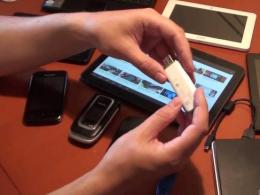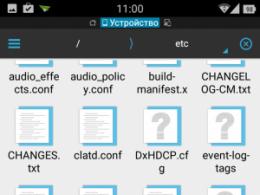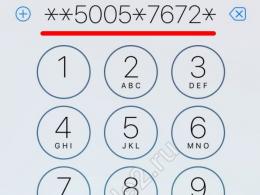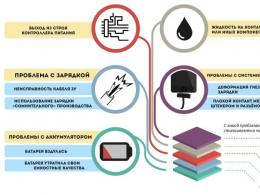Move app to miui sd card. How to transfer applications to a memory card on Xiaomi
Not all smartphones have enough built-in memory to save all the data in the right amount. In this case, the most practical option is to use an additional memory card. However, not every mobile device Xiaomi company allows you to transfer applications to micro SD, as a result of which they are left in the gadget system.
Next, we will analyze how to most easily transport to external drive programs, basic methods, what services should be used to solve the problem, and also why such information should be stored outside the smartphone.
Why store data on an SD card?
If unexpected failures occur in the software part of the phone, one of the most effective options is to reinstall operating system. But as a result, all user data is deleted, so it is much more reliable to copy them to a separate USB flash drive so that in any situation access to the necessary information remains.

The next option is a breakdown of the gadget that cannot be repaired. In the end, do nothing. But if you have a backup, all data can be opened through another device. In addition, some services, such as Whatsapp, allow you to save messages to micro SD, so you can always restore correspondence.
In practice, the site often encounters situations in which gamers quickly fill up the memory with “heavy” games, which causes the user to run out of space.
Methods for transferring applications
Almost every Xiaomi model lacks the usual carry option. Thus, if you go to the "Apps" section in the phone settings and select any of the available ones, in most options the "Move to SD" function will not be available. Therefore, it is necessary to use third party programs. We will recommend several popular services that will allow you to transport software to an external drive.
- Clean master - the most standard method. Go to the service and select "Application Manager". Mark the points for transportation and click on the inscription "Move". However, sometimes the option may be disabled. Therefore, if this advice turned out to be ineffective, then use another method;
- AppMgr III (App 2 SD). advantage this option is to work without superuser rights. After logging in, a list of all programs will open. Go to the special menu by swiping from left to right and select the "Move app" option. Next, a list will be displayed in which you need to select one item and act in accordance with further instructions;
- The program needs to work root permissions. The meaning of the work is identical, go to the service and select the desired option from the list, then find the “Move to SD” function below. Confirm the action and complete the operation. Despite the fact that the functionality is provided for free, there is a paid version with additional features and no ads.
- Folder Mount. A very popular service through which applications can be transported, but superuser rights are also useful for its use. On the first page of the program, the inscription "The list of pairs is empty" will appear. Drag your finger from right to left to bring up the menu and click "App Activator". Go to the desired game, where there will be two options: data and obb. One of them should be available, then select Pair. A notification will appear asking you to create a target folder, where you need to answer "Yes".
The following page will open, displaying the name, location, and destination (the folder on the memory card where the application data will be transferred). By clicking on the checkmark at the top of the window, you confirm your action. By lowering the notification shade, you can check how many percent are completed.

At the end of the procedure, go to the main menu of the service, where you can find the created pair. Activate it using the slider next to the name. This action enables the connection between the program and the corresponding folder located on the microSD after the completed tasks. Folder Mount was tested on the WhatApp messenger and the task was successfully completed. Also on the Web you can find videos with instructions from specialists. Despite frequent service updates and design changes, all options and keys have retained their location.
How to move game cache?
The most popular question from mobile gamers is how to transport the game cache? If you are downloading a large application from a pre-installed store, then at the end of the download you can also transfer your progress to microSD using Folder Mount. It should be noted that in some games the program itself is moved first, and the cache is installed after it is activated, since a request will appear to download the necessary files. In some cases, when the device's memory is not enough, the application offers to immediately send everything to the SD card, and no additional manipulations are required.

However, in other situations, when a window appears with a notification about the lack of its own memory, the game refuses to transfer the cache to an external drive. You need to find the application on the Internet, or on a specific resource where you can download setup file apk and the archive separately, unpack the information of the latter yourself, into a folder, which, as a rule, should be indicated in the description of the program.
Conclusion
A mobile device can always fail, for example, due to a breakdown, and it does not matter who was at fault. You can always purchase another device, but if you have a backup on the memory card, all personal data from desired programs it will be much easier to return to the phone. Following the above, Folder Mount is the most practical option for transferring apps to microSD, which does its job perfectly.
Over time, even smartphones do not allow you to save to internal memory new files and downloads as it ends. In this case, just by the way, a micro-card. There is a slot for it in all modern gadgets. However, this is only the most obvious reason for using an external drive.
The expediency of transferring data from Xiaomi to a memory card
The mass of downloadable services from unverified sources make Xiaomi smartphones vulnerable to viruses, and their active mode simultaneously makes the system work for wear and tear. As a result of this, the gadget often freezes and needs a deep reboot. After the actions taken, most of the files “flies” and it is not always possible to restore them. In order not to lose important data, you should create backups for meaningful photos, notes, etc. to external media. Another reason why it is important to periodically “transfer” information to SD is to free up phone storage for normal operation.
If transferring pictures is not difficult even for the most inexperienced user, then the situation with software is more complicated. By default, this function is prohibited in Xiaomi, and this can be done through third-party programs.
How to transfer apps to Xiaomi card
This program is one of the most banal and often found in the new phone (as a bonus from the manufacturer). The use of labor will not amount. After starting, select “Application Manager”, mark the services and use the “Move” button to send them to a removable drive. However, the transfer function is not always possible.
2. AppMgr III (App 2 SD)
The utility is effective and does not require root rights. When you start the program, a list of installed software will appear on the screen. To send, you need to swipe the screen to the right and select the line with the move. Only the software allowed for transfer will remain in the list. Choose what you want and follow the instructions.
The limited resource for storing files on smartphones forces the user to look for an opportunity to install the application on the card. Although the task seems simple, there are few ways to solve it. Let's consider the simplest ones.
By switching from internal memory to external
In Xiaomi, it is recommended to install the application on a memory card after copying all the files stored on it. Otherwise, they will be lost during the pairing process. After the manipulations are performed:
1. Go to “Settings” - “Storage”, click on the SD card.
2. At the “three dots” click on “Storage settings”

3. Open the line "Internal memory"

If a warning message appears on the screen slow work microsd, then it should not be ignored, otherwise the device will be unstable. Definitely needs to be replaced.
5. After the cleaning is completed, you should mark the services for downloading to an additional file storage resource.
6. Reboot.
It is important to note that now the information stored on the SD will be encrypted and not available for recognition on another device. Simply removing it from the slot can cause Xiaomi to malfunction.
You can detach the card from the phone in the “storage settings” by checking “Portable media”.
Via adb driver
In Xiaomi smartphones, you can force the installation of the application on SD. Requires ADB driver, PC and USB debugging permission. After the utility is downloaded on Windows, it needs to be run.

On the computer, enter one of the following commands:
- Su - if you have root rights, or skip;
- pm getInstallLocation("0" by default);
- pm getInstallLocation 1 - installation in the phone's "native" memory;
- pm getInstallLocation 2 - install on a portable device.
Not all users will want to execute this algorithm, and for some it will seem incredibly complicated. But the method is considered effective, and in case of failure of other options, it can help out.
The burning question is how to Xiaomi Redmi 4X to transfer applications to a memory card is quite common, as well as the answers to it, only few sensible ones. The review is intended to put everything on the shelves and bring clarity to the solution of the problem for any model of the device.
And really, why? If Xiaomi had a problem with RAM, so this is not observed. More and more capacious chips are allocated for the phone's memory every year. Even the budget line in the latest versions is equipped with 3-4 GB of RAM, which will provide all conceivable and unthinkable user needs. Even taking into account the fact that MIUI's proprietary shell takes from 1 GB or more to work, depending on the model.
A flash drive is used today mainly to store backups on it, that is, a system image in which a “cast” of all installed apps and device settings. What is especially important in a situation that requires the restoration of the original state.
A factory reset clears the settings completely and deletes everything from the phone's memory. He does not touch only the memory card, which can be used at a time when the smartphone behaves inappropriately, does not obey the commands of the owner, is buggy and naughty. And you decide to hard reset, followed by roll forward of the saved data from the memory card.
Another case when you need a backup of the device is very often found in numerous instructions for flashing phones. If you decide to change the system for some reason, then you need to protect your files from being destroyed by the firmware program. Since, again, as in the case of a factory reset, your phone memory will take on a pristine state.
Do not forget about the fatal case associated with the complete collapse of the device. The breakdown is so significant that recovery will require not only software, but also hardware intervention. It is useful to have backup copies of everything that is possible on a separate medium.
And the last factor, it is connected with the realities of today. Media files are streamed to instant messengers, game caches and online services, increasing the amount of information by orders of magnitude. And the games themselves take up so much space that no Xiaomi equipment, even the most luxurious one, will provide the required memory size.
Methods for transferring applications

It's amazing how quickly information on the Internet becomes outdated. What was previously impossible, with the advent of firmware updates, becomes quite real. Recommendations are made irrelevant and give rise to a hail of angry indignations: “But I can’t do it!” This article uses only the most up-to-date information. And I experimented with my phone. Screenshots are not taken from the network, but made by me personally.
I note right away that you need to start the process by inserting a micro SD into Xiaomi. Yes, yes, don’t laugh, if you suddenly decide to set it up first, and then you won’t be able to insert anything. There will be no necessary options in the settings, since the smartphone, not seeing an alternative, will not offer anything. The same goes for installed programs, cannot be transferred. Since there you will not see anything suitable for yourself. Applications installed in the internal memory will remain in it.
Through settings
The method was carried out on the Xiaomi Redmi 4 Pro device, which is quite “old” by the production date. There have been mentions on the net that MIUI does not allow you to customize the movement using the system settings, but this is not entirely true. References were made only to individual latest flagships, where, they say, this algorithm was finally registered. Now check the opposite. And for greater reliability, I provide screenshots taken in the sequence described below.


On the last screen you can see where to finally click so that the applications are installed on the SD card.
Sometimes something goes wrong, many complain that they don’t have one option in the settings, then another, then the application does not allow you to do anything and change it. Please do not rush to conclusions and check everything again. I, too, am not seven spans in the forehead, burst, without initially inserting a memory card into the phone. In the end it didn't work no matter how hard I tried.
Applications
The method seems to be even simpler, but it was not there. It is possible to transfer applications to a memory card in Xiaomi using programs, but in almost all cases you will need root rights. If you want to get confused, then read about obtaining rights. The simplest, since the entire process of obtaining rights is quite long and is not included in the scope of the article, is to install the developer firmware on the phone and enable root permissions in the settings of the smartphone itself.
First, let's mention an application that, according to reviews, does not require special permission. AppMgr III (App 2 SD): Install on the phone and go into the program. The only thing to do is to move the application. True, the list of files allowed to be moved is incomplete, something will be missing. That's the price you pay for not having superuser rights. All of the above applies to simple solution- Cleanmaster. It will move without problems, but not all. Which doesn't suit us.
Another program from the Play Market - Link2SD - has full functionality and will do everything. If you have the already mentioned root rights and a flash drive correctly divided into two sections. Otherwise, you get the following picture:

The first figure shows that the program is running and ready to "send" the application (compass is selected). But where will it be sent? In a properly configured flash drive, at the very bottom of this Link2SD window, an inscription will appear - To an SD card. It is not here, moreover, the system asks you for some action with the SD card, without which it is impossible to complete the transfer procedure.
So, there is a flash drive, but we cannot move anything to it. Just like in Krylov's fable, about a crow with cheese. Will help with this free program MiniTool Partition. The download link is taken from the original site in English.
Next comes the splitting procedure, in pictures. From w3bsit3-dns.com website. I deliberately did not describe the entire procedure here, otherwise it will turn out to be an article in an article.
After completing all the preparatory work, you can easily move everything you want to a USB flash drive.
For our goal, namely, to move the entire heavy cache to the SD card, the FolderMount program will help.

At first, a few years ago, the process was available exclusively for advanced users. He was so intricate and required special knowledge in the operation of the computer. With the advent of this application, the situation has been noticeably simplified, the final destination has become visible. Actually, for what everything is done.
Launched modern games and so themselves take up a lot of space. But it is especially worth noting that the cache, a necessary component of all dynamic arcade games, all these shooters, catch-ups and other attributes of a gaming life, “weighs” even more. The question of relocation has become quite acute, it is not for nothing that the flagships equip the phone with unthinkable numbers of the total memory of the phone. It reaches a quarter of a terabyte, some kind of madness.
But FolderMount appeared, and many breathed a sigh of relief.
Install the apk file downloaded from the Play Market and run it. Next comes the setup procedure, the meaning of which boils down to specifying and moving specific cache folders from a folder from internal memory to a folder on external media. For different games The names are different, but the meaning, I think, is clear. For clarity, an example of setting for a specific game is given.

As you can see from the screenshot, there is a cache source, and there is a destination folder where you need to simulate sending data. To start the setup, you need to click the small plus sign in the upper right corner of the program.
A small fly in the ointment: the program is shareware (like everything in this world) and after three mounts, it refuses to work. For full operation, you need a paid pro version.
Other possibilities for manipulating the cache are related to downloading the game itself and the cache itself on the network. Many games are presented this way. After downloading what you need, insert the folder with the cache contents on the memory card and forget about it.
Some games practice prompting during installation, asking you to specify where to mount the cache. Naturally, we indicate the best way.
Possible errors and solutions
These are bugs associated either with the flash drive itself or with the phone. The third, as you know, is not given.
You can save data on the SD card if it does not have bad sectors, it was bought from a normal seller and there is a guarantee for its quality. A million cases related to the "disappearance" of files, errors during playback and launch of applications are associated with damage to the memory card. Relentlessly pull out.

The following errors: the smartphone writes that it is impossible to install this application.
Helps in each case is different.
If the reason is a malfunctioning firmware, then for complete certainty, you should install the developer version in order to exclude the option associated with the lack of root rights. Many are experimenting with custom recovery and firmware, where the procedure for patching and gaining super user rights is much easier. It is included in the phone settings.
It is also important how the flash drive was prepared for work, formatted and partitioned. Those restless with custom can reap the fruits of their work: flash drive marking is possible not in a computer, but directly on the phone from under TWRP or CWM recovery. These functions are all spelled out there, just insert a memory card into your smartphone.
Data transfer to Xiaomi card today it has become much easier, ways have appeared in the settings of the smartphone itself, new applications have learned how to solve transfer problems. I think that it will not be difficult for you to understand simple issues related to changing the amount of memory in your phone.
Recently, everything has entered the world market more smartphones with a huge internal memory, but the question "How to transfer applications to a Xiaomi memory card" is still relevant. After all, there can be many reasons, as we will discuss below.
We note right away that this procedure can be carried out only if the phone has a special slot for a flash card, or a hybrid slot (that is, a slot into which you can insert either a second SIM card or a flash drive).
External memory (MicroSD) is much slower than soldered built-in. Installing programs and various applications leads to obvious “brakes”, which causes unstable operation of the device and other unpleasant moments.
Why transfer apps
- First, let's list the advantages of the SD card. The first is, of course, the safety of important data after a smartphone breakdown. Quite often it happens that the device is no longer repairable, and access to the materials is lost. Another thing is the memory card. After extracting it, you can easily place it in another device and use the necessary information from there: photos, videos, documents, games.
- Slightly different situation there have been major disruptions in the operation of the operating system and is needed. As a result, all internal memory is cleared, the phone returns to factory settings, all accounts are logged out and password auto-fill is disabled. The changes do not affect only the SD card. For reinsurance, it is better to remove it before flashing it.
- And the most banal lack of free space. Are you an avid gamer and love 3D games, or work as a programmer and a large number of various applications on the phone is simply necessary? In both cases, you simply cannot do without the use of a flash card.
Working way to transfer apps to Xiaomi via Activity launcher
A good effective method that only works on smartphones running . If an earlier Miyuay 9 shell is installed on the phone - possible program crashes.
We will need a special application called , which is freely available on Google Play. Also, the tool can be downloaded from the user forum w3bsit3-dns.com.
We warn you in advance that the procedure is multi-stage and may seem complicated for beginners. But this is practically the only effective option for Xiaomi devices.
- So, download and install the launcher. We fall on home page, where we see the items "Activation of applications" and "MIUI desktop". We won't need them just yet. Click on the top tab "Last Actions", where we choose "All Actions".
- The system processes the applications installed on the smartphone. Now we press "The documents", and in the drop-down menu pay attention to"Downloads: com.android.documentsui.LauncherActivity".
- A new page opens. Tap on the left side menu « SD-map", then click on the ellipsis, in which we select the line"Memory".
- Expanded storage settings are highlighted. Click below "Inner memory". We receive a warning that now the memory card will be formatted, and, accordingly, all data will be deleted. That's whybe sure to transfer important materials to a computer or to cloud storage before starting the procedure.
- We agree to the end of the procedure by clicking "Clean and Format". Done, now the external drive is able to receive games and programs from the internal memory.
In order to move, you will need:
- Go to "Settings" – "Applications". Here, open the page of the application you need;
- Now click on the item "Vault" and specify on which drive you want to store the material. That's it, done.
How to transfer apps to Xiaomi memory card through settings

Unfortunately, MIUI has a significant drawback - the lack of a system transfer. Some Xiaomi smartphones still support this feature, but not latest versions. To check, do the following:
- We are looking for the "Settings" icon on the main screen, we go;
- Now "Applications";
- We select the one of interest, and if transferring in this way is possible, we see a small icon "Transfer to SD". In case of absence, they come to the rescue special applications, which we will discuss below.
Enough simple program, which can be easily downloaded from Google Play and installed using the usual method. Only required for correct operation obligatory presence. We see a list of installed applications, click, for example, on the desired game, scroll down the page a little and click " Move to SD card". Ready. As we see, this way almost identical to the system.
Problem 1: What to do if the mount script cannot be created
The application fails to create the operation script and the whole transfer process ends in the middle. What is the problem? There may be several reasons:
- Your phone or tablet does not support the requested file type.
- Ruth was not received (described below).
- The file system does not support Ext, format both partitions FAT32.
- Perhaps you want to transfer an application that the system has forbidden to transfer. Sort the list of applications by "Supported by App2SD".
Problem 2: Error - Link2sd could not get root permissions
In this case, there are two ways out of this problem:
- You have incorrectly or incompletely set Superuser Rights to your phone. Read our instructions. (link above).
- Crash in the program itself. Try restarting your device.
Migrate apps with Clean master
A very simple and banal option, which, unfortunately, does not always work and not on all models. Again, we use Google Play to download. The application, in addition to the transfer, has several more useful functions:
- Cleaning the device from unnecessary garbage and duplicate files;
- Removing tasks;
- Removing, moving various games, utilities, etc.;
- Even a backup is possible.
On the main screen of the program, select "Application Manager", then tick off those that we want to move, and at the bottom we activate the blue button of the same name. Made.
Folder Mount (ROOT)
Good and efficient application with two cons- the need to do a lot of manipulations and the obligatory the presence of Ruth rights. But with a probability of almost 100%, the materials will be successfully transferred to a flash card. Getting started:
- After installing the utility, open it, get to main screen and we see the inscription "The list of pairs is empty";
- By moving to the left, we call up the side menu: “List of pairs”, “Partition size”, “Application analyzer”. Click on the last item
- Two windows pop up "data" and "obb". One must be active
- Now " Create a couple", we confirm the displayed notification;
- Next, a new window appears called " Folder options". We see the file name, source (where the material is located in this moment) and destination (where it will be moved). If all the information provided is correct and suits you, click on the checkmark at the top of the screen.
- When opening the top curtain, we can see how many percent have already moved;
- And the last final action: after the end of the move, we return to the original Folder Mount window, where we turn on the slider between the application and the moved folder on the SD card.
AppMgr III (App 2 SD) - without ROOT
A lightweight program that does not take up much space on the internal memory of the phone and does not require any special technical knowledge, skills and a lot of time spent. There is also no need for root rights.
If you want a simple and quite effective way - this application is the best solution.
Lights up immediately after startup full list available applications. Move to the right to open the left side menu and click "Move" - "OK". That's all.

You can transfer application data, but not completely. This transfer can only be done using the Folder Mount program. All other applications do not support this function. If the cache is downloaded simultaneously with the main game - there are no problems, use the above utility.
Does the cache start downloading after the first launch of the game? Then, first you are asked for permission for this action, and then a choice is offered: on the internal memory or on SD. Accordingly, we choose the second. And the last option is to download the cache from the Internet yourself and install it on a flash card on your own.
To avoid such problems in the future, remove the card before starting the operation. Restore with basic functions unfortunately not possible.






